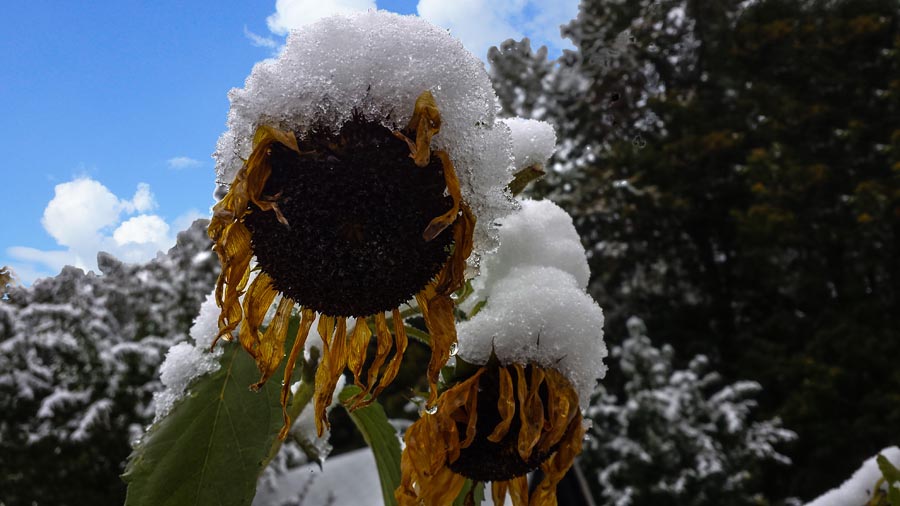
Generally, when a sunflower is in full bloom you have just around 20 days to enjoy the beauty of the flower.
Now of course for many following its entire growth journey is just as important.
But for a plant that is associated with warmth and sunlight, it seems almost incomprehensible that you could begin the process of growing one in the winter.
So can you winter sow sunflowers?
The answer might surprise you…
Can You Winter Sow Sunflowers?
Yes you can sow sunflower seeds in the winter and it can actually produce hardier plants that should germinate at exactly the right time. You just need to follow a few simple steps to create your own mini-greenhouse to protect the seeds in the winter and then transplant them into the soil around the time of your last expected frost.
Growing Sunflower Seeds in the Winter
Unless you live in a frost-free, eternally sunny environment, winter sowing sunflower seeds is slightly different from the more traditional method of growing sunflowers, but it can actually have big advantages.
The main benefits are:
- Winter sowing will produce a much hardier plant, that will not need to acclimatize to growing outdoors as it will be used to it.
- The seeds should germinate at exactly the right time.
Now whilst some seeds might not make it through the winter months if you sow multiple seeds some will and you will be rewarded with bright, beautiful and vibrant sunflowers.
How to Winter Sow Sunflower Seeds

The process of winter sowing sunflower seeds involves creating a protective shelter for them, so they can be shielded from the elements that might otherwise damage them.
Start by buying high-quality sunflower seeds and then make sure you have the following items:
- An empty plastic milk jug
- Potting soil
- Scissors
- Duct tape
- Labels
That is really all you need to help sunflower seeds grow in the winter. Then just follow these steps:
STEP 1: Make Your Seeds a Mini Greenhouse
Remove the cap from the milk jug and then begin to cut around it with the scissors about one-third of the way up from the base.
You don’t want to cut all the way around. You need to make sure you leave a small section uncut, around two inches in length, so the top and bottom of the jug remain connected.
STEP 2: Create Drainage Holes
Use the scissors to pierce several holes in the base of the jug. These will act as drainage holes.
RELATED ===> Will Clethodim Kill Sunflowers?
STEP 3: Add the Soil and Sow the Seeds
Fill the jug with potting soil until it is around three-quarters full and begin to sow your sunflower seeds. Sow the seeds around one inch deep, and leave a gap of around two inches between each.
Don’t worry too much about sowing too many seeds in a limited space as eventually you will be transplanting them into your garden. Water the soil and seeds.
STEP 4: Attach the Two Halves
Using the duct tape, reattach the top of the jug to the bottom. You now have a mini greenhouse that protects the seeds whilst they sprout.
STEP 5: Place the Mini Greenhouse in Your Garden
Find a sheltered spot in the garden and place your mini greenhouse there. Water if necessary and if you get any unseasonably warm days (we are talking about temperatures in excess of around 70°F) remove the duct tape and open the top to stop the seeds from overheating. Remember to duct tape it back up at night.
STEP 6: Transplant the Seeds Into the Ground.
Take great care to transplant the sunflower seeds into the garden. You should do this around the time of your last expected frost or when the plants reach two inches in height.
By now the sunflower seeds should be much more tolerant to cold temperatures than if they were grown indoors and should be hardy enough to deal with any unexpected light spring frosts.
There you go, it really is that simple!
When you do transplant the seeds into the ground be as gentle and careful as possible. You don’t want several weeks and months of hard work to go to waste in your haste to get them in the ground!
When to Winter Sow Sunflower Seeds

If you are wondering how late you can winter sow using this method, it shouldn’t matter too much as you have created your own unique ecosystem for the sunflower seeds.
It also depends on where you live and the weather. Even though you have built a protective shelter for your seeds, if you live somewhere where you get VERY cold winters, it might still be too much for them.
RELATED ===> Will Treflan Kill Sunflowers?
On the other hand, fluctuating temperatures in the winter may stimulate early germination, as the seeds might struggle with a spell of unseasonably warm winter weather followed in quick succession by some very cold winter weather.
If I was going to pick an ideal time to start winter sowing sunflower seeds I would say at least wait until the Christmas season is complete and start anytime from January onwards.
The temperature should have stabilized by then.
But really if you follow the steps closely, and plant a number of seeds, then no matter what the weather you should see some beautiful sunflowers blooming in your garden in the summer.
Don’t Forget There Are Perennial Sunflowers
If you want to extend the season of color in your garden, don’t forget there are perennial sunflower plants.
Believe it or not perennial sunflowers actually make up the majority of sunflower varieties native to North America.
They are smaller than their annual siblings and might not be as visually impressive, but they make up for what they lack in size with profuse blooms that last into late summer and fall.
Popular varieties include Capenich Star and Loddon Gold, whilst some can still reach impressive heights, the Willowleaf and Maximilian variety can grow up to ten feet.
Perennial sunflowers are bright and cheerful, pest-free and easy to maintain.
RELATED ===> What Do Sunflowers Smell Like?
Final Thoughts
So as you can see the answer to the question, “can sunflower seeds grow in winter?” is a most definite yes.
In fact, winter sowing seeds can produce hardier plants and result in bright, beautiful sunflowers.
Making your own mini-greenhouse to sow them in is quick and easy too, and once that is done you really don’t have to worry too much about them.
When they are transplanted into the soil they should be much better set to deal with any adverse weather conditions that might be thrown at them.
It is definitely worth trying and makes a fun project if you have young children too.

